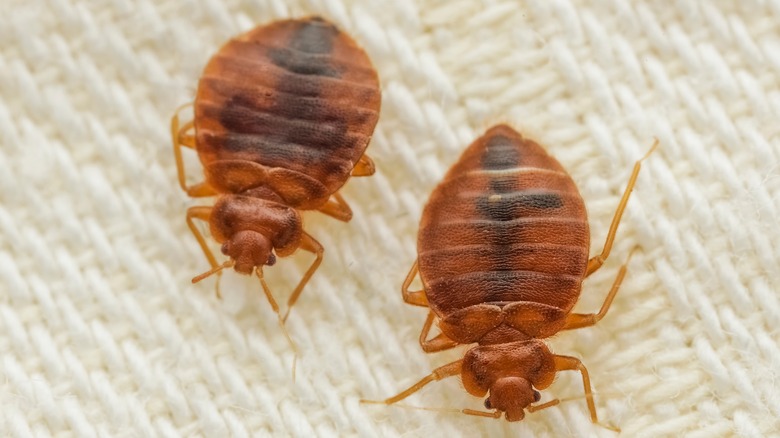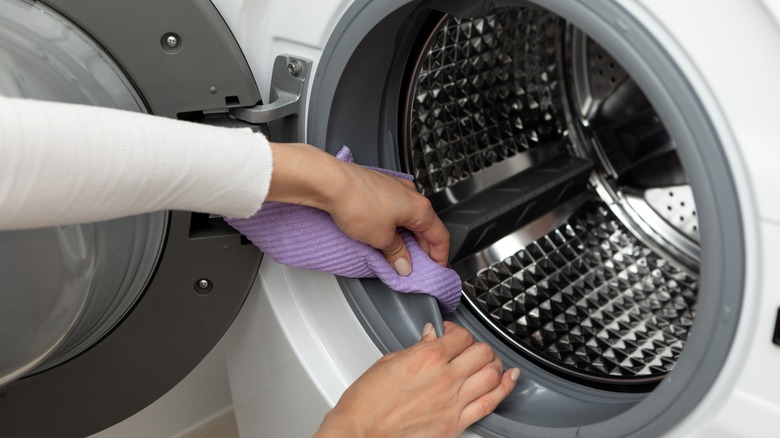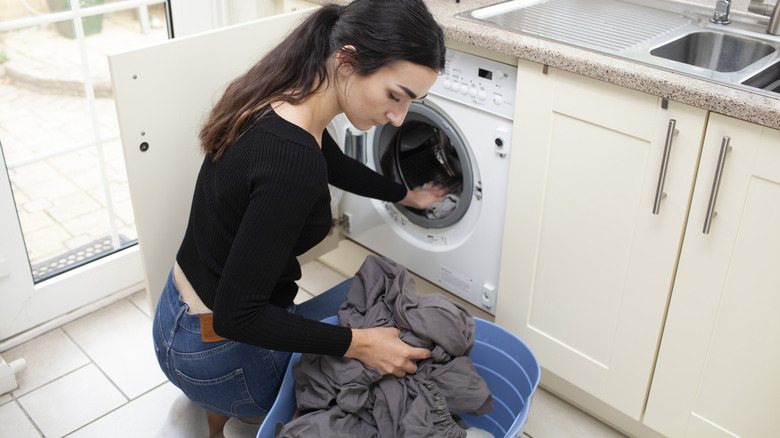The Best Way To Clean Your Washing Machine After A Bed Bug Infestation
It's the household nightmare that seems to go on and on. First, you suffered the disheartening discovery of bed bugs. Then, you had to sterilize the mountains of contaminated clothing and linen. Now, you have to sanitize the washing machine used to kill off the nasty pests. Fortunately, the common cleaning appliance is an effective tool to eliminate the tiny bloodsuckers using a high heat wash. Unfortunately, the machine won't get rid of residual bed bug debris on its own. The best way to clean your washing machine after a bed bug infestation requires a vacuum, hot water, and disinfectants.
It's hard to believe a creature smaller than a pencil eraser can initiate so much cleaning. However, given that a female bed bug can lay roughly 500 eggs in her lifetime, it is critical that all items that may have been exposed to the rapid reproducers — including pillows, bedding, stuffed toys, and clothes — are run in the washing machine using water that is at least 140 degrees Fahrenheit for 90 minutes or more, followed by an immediate transfer to a dryer set on the highest heat for a minimum of 30 minutes. The extreme temperatures are effective in terminating bed bugs and any unhatched eggs; however, blistering hot conditions alone will not guarantee that your machine is completely free of lingering bed bug remains. Washing machines contain numerous cracks and crevices where the puny insects' carcasses and residue can dwell even after the wash cycle is done.
How to use a vacuum and disinfectants to a clean washing machine after a bed bug infestation
Decontaminating a washing machine used to kill bed bugs is an important task if you want to ensure a complete eradication of the tiny terrors. To start, empty the washing machine as soon as the load of affected bed bug items is complete and allow the appliance's drum to thoroughly dry. Next, regardless of whether you own a front-load or top-load washing machine, it's best to place a brush attachment on your vacuum before using it inside the inner tub. As you use the appliance to suck up bed bug remnants really focus on the holes perforated in the drum, as well as the machine's seals, and any isolated areas.
Next, in a spray bottle combine equal parts water and vinegar. Shake well and spritz the solution inside the inner drum making sure to completely saturate all surfaces including the agitator, if your machine is equipped with one. Allow the vinegar mixture to sit for 10 minutes before wiping it off with a clean white cloth or a sponge. When that's done, sanitize the machine by pouring ½ cup of vinegar in a standard washing machine or ¼ cup in a high-efficiency version, then run a wash cycle on the highest temperature setting.
Other sanitizing methods for washing machines used to kill bed bugs
Steam cleaning a washer may seem like overkill, but when the appliance has been used as a death chamber for bed bugs, the extra step is often necessary. Handheld steam cleaners designed for hard or multi-surfaces work best as they're small enough to access hard-to-reach spots in a washing machine's drum. Work in sections using the device to steam all surfaces. If you're concerned about particular areas harboring residual bed bug debris, connect an attachment to the steam cleaner to scrub or scrape the spots. Once you're done steaming the washer's basket, use the tool on the detergent dispenser, the machine's door, and seals. If you don't have a handheld steamer, simply use a hot water and vinegar solution to wipe down the washer's detergent compartment, filter and its housing. Finish by using the steamer on the exterior of the washing machine, then wiping with a microfiber cloth. Otherwise, just use some mild soap and a damp cloth to give the outside of the washer a quick scrub.
Finally, if you don't have time to mix up homemade disinfecting solutions, consider using commercial washing machine cleaners. They are sold as powders, liquids, or tablets and give the washer a deep clean following bed bug remediation efforts. Follow the instructions printed on the product's container; however, keep in mind that you may have to run more than one wash cycle with the cleaner to fully remove all unwanted insect sediment.


